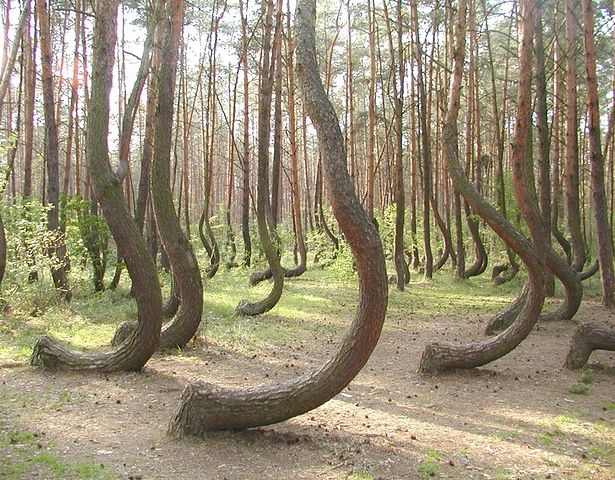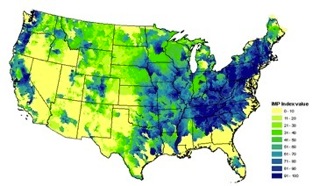Forests are a valuable resource

"In his biggest decision ever in the environment, President Bush has moved to open up 1/3 of all remote national forest lands to road building, logging, and other adventures. This is part of the no tree left behind. In fact, if you would like to see one of our Redwoods they will be at Home Depot next week."
--Jay Leno on the "Tonight Show"
Take the Wildlife Pledge
Follow these four easy steps to preserve wildlife in your own back yard.
1. Food. Provide as much vegatation as possible,
including shrubs, trees and other plants that produce foods such as acorns,
nuts, berries and toehr seeds.
2. Water. Make water available through a birdbath, a small pond,
a recirculating waterfall or a shallow dish. Wildlife needs water
for both drinking and bathing.
3. Cover. Provide protective cover for wildlife through densely
branched shtubs, hollow logs, rock piles, brush piles and stone walls.
After the holidays you can your your old holiday tree in the backyard for
a frewmonths. Its an easy way to provide the needed cover.
4. Places to raise their young. Build birdhouses and nesting
shelves attached to posts, trees or to a building. DFense plantings
of shrubbery provide safe areas for many species of wildlife. Species
such as salamanders, frogs, toads and insects require a large body of water
as a safe haven for raising their young.
Here is an excellent forestry education site for students: http://forestrydegree.net.
Searching for the best forestry-related degree program can be a time-consuming task, and it is certainly very competitive. This site is designed to help students who are interested in forestry degree programs find all the info they need by visiting one site. Most existing forestry school sites are either outdated or very commercially oriented.
___________________________________________________________________________
 Forests to faucets
Forests to faucets
HUMANITY LOSES $250 BILLION A YEAR IN WILD HABITAT
http://ens-news.com/ens/aug2002/2002-08-09-07.asp
AN ATLAS OF BIODIVERSITY MAPS HUMAN IMPACT
SEATTLE, Washington, January 18, 2002 (ENS) - A new forest conservation company plans to buy 100,000 acres in Washington state to protect the tract from development.
Evergreen Forest Trust and the Weyerhaeuser Company have agreed on terms for the sale of 100,000 acres of forestland in the foothills of eastern King and Snohomish counties. The Trust will continue to harvest timber from the land, but it will also preserve sensitive areas near rivers and steep banks.
Evergreen Forest Trust is pioneering a new forestland ownership and management concept. Created by regional business, political and environmental leaders, the Trust defines itself as a nonprofit forest conservation company.
The Trust's goal is to keep forestland from being converted to other uses. The land transaction announced Wednesday is the Trust's first acquisition. The property will now be called the Evergreen Forest at Snoqualmie.
"The Evergreen Forest at Snoqualmie project guarantees that this magnificent landscape will remain as forestland forever," said Gerry Johnson, president of Evergreen Forest Trust and managing partner of the Seattle law firm Preston Gates & Ellis LLP.
"Weyerhaeuser recognized the public benefits of keeping this parcel forested and agreed to sell it to the Trust," Johnson said. "Forestland owners near urban areas face increasing pressure to convert their land to higher value uses, including residential and commercial development. Evergreen Forest Trust's ownership ensures the land will remain as a working forest and removes the pressure to convert it to development."
The Trust plans to finance the $185 million transaction by selling Community Forestry Bonds, but needs a clarification of federal tax law to permit issuance of the tax exempt revenue bonds. The sale, which is contingent on the Trust obtaining financing, is expected to close by mid-summer.
A conservation easement held by the Cascade Land Conservancy (CLC), which helped negotiate the transaction, will preserve the most sensitive areas and provide additional environmental protections for the entire parcel.
"Although timber will continue to be harvested," noted CLC president Gene Duvernoy, "the conservation easement placed on the Evergreen Forest will ensure that there is broader protection for sensitive areas, and that wider preserves are maintained along steep banks, rivers, streams, wetlands and lakes."
The Evergreen Forest is located within the ranges of the northern spotted owl and marbled murrelet, and contains habitat for numerous salmon species and other wildlife. It includes two major rivers - the North Fork Snoqualmie and Tolt - numerous smaller rivers, more than 500 acres of lakes and ponds, more than 6,000 acres of riparian areas along rivers and streams, and more than 4,000 acres of wetlands.
The purchase price does not include rights to underground minerals, which are retained by Weyerhaeuser.
"Weyerhaeuser has a long history of cooperation when there is a high level of public interest in a parcel of our land," said Richard Hanson, Weyerhaeuser's senior vice president of timberlands. "The Snoqualmie Forest has sentimental value to many of us at the company. We are pleased that this special land will continue to be managed as forestland."
By Mary Powers
http://ens-news.com/ens/aug2002/2002-08-09-01.asp
NEW AGENCY RULES IMPERIL DECADES-LONG FOREST MANAGEMENT PROCESS
Since 1976, we've managed America's priceless national forests under the National Forest Management Act (NFMA). The Bush Administration has upended that longstanding system in favor of one designed to maximize agency discretion and to minimize public participation in decisions that affect our forests. Besides dumping the Roadless Rule that protected nearly 60 million acres of pristine forest, the U.S. Forest Service has moved to impose new regulations and directives that sharply weaken the forest planning process. The agency is accepting public comments on the NFMA directives until June 21, 2005.
*****************************************
BACKGROUND
In 1976, the Congress enacted the National Forest Management Act, requiring the Forest Service to develop land and resource management plans for each of our National Forests at least every 15 years. An essential provision of the legislation was thorough public involvement at every stage of the planning process. The Reagan Administration, with the help of an independent Committee of Scientists, adopted regulations in 1982 to guide the forest planning process. In 2000, the Clinton Administration issued new NFMA regulations that retained a prominent role for public and scientific input. The Bush Administration quickly suspended them, leaving the agency to operate under the 1982 regulations until January 2005 when it published new ones.
BUREAUCRATIC DISCRETION REPLACES ENVIRONMENTAL SAFEGUARDS
To say that the original NFMA rules adequately protected the national forests is to exaggerate. But it is wholly accurate to say that citizens interested in the management of our forests greatly benefited from those rules and used them to participate effectively in planning matters. The interim rules change that and change it markedly. Timber cutting could be allowed in any forest outside wilderness or other statutorily protected areas. Where once the agency was REQUIRED to manage to protect such things as species viability, that protection is now discretionary. Where once the agency had a duty to ensure that its management decisions comported with the best available science, the role of science is now diminished to just "one aspect of decision-making" and not even the MOST important: "competing use demands" can now override science. And where once the agency was required to prepare an environmental impact statement under the National Environmental Policy Act (NEPA) whenever a forest plan was revised or significantly amended, the agency is now free to "categorically exclude" forest plans from the clear terms of NEPA.
MAJOR AREAS OF CONCERN
A bedrock strength of the NFMA was its requirement that the agency operate to maintain viable populations of fish and wildlife species on our national forests. That provision was the legal basis for such things as the Northwest Forest Plan, the Sierra Nevada Conservation Framework and many other wildlife and old-growth habitat conservation strategies. It served us well. Now it's gone. Instead, the new regulations contain only an "overall goal" to "provide a framework to contribute to sustaining native ecological systems." The directives are similarly vacuous, giving broad discretion to the forest supervisor to protect sensitive species populations "to the degree determined appropriate." This inexcusably weak direction extends even to state-listed threatened and endangered species, and other species of regional or local concern due to significant threats, declining populations or rarity.
NEPA "LITE"
In addition to scrapping the species viability requirement, the 2005 regulations sparked more controversy by exempting forest plans from the normal requirements of the National Environmental Policy Act. Specifically, the new rules categorically exclude forest planning from the NEPA requirements to prepare an environmental impact statement (EIS) and to consider a range of alternatives. There are, to be sure, NEPA-like elements in the new directives. But they lack the clarity of the earlier rules and trade duty for discretion. While the forest supervisor MAY consider a range of options, as under NEPA, there is no guarantee that the agency will do so. And there is no assurance that planners will consider the cumulative effects of logging, grazing, mining and off-road vehicle uses of the forest. There's no assurance, either, that the agency will provide the public enough information to make informed comments on the agency's proposal or options (if any).
A WILD CARD
The new planning process will involve an Environmental Management System
or EMS. So what, exactly, is EMS and what does it mean for national forest
management? The agency has never before used the device and no one knows
how it will affect either planning or on-the-ground management of our forests.
Sadly, neither the regulations nor the directives are much help in
clarifying the meaning of EMS or its relationship to forest planning. Worse,
there is no evident role for the public in the design or application of
EMS, leaving the impression that EMS is better suited for private corporations
than for public land agencies.
Adding insult to injury, citizens will have to pay dearly to learn the secret requirements of EMS. The regulations state that the EMS must conform to standards developed by another entity (the International Organization for Standardization or ISO) and embodied in "ISO 14001." The Forest Service says the standard is available on the ISO web site. But it isn't free. Citizens have to shell out an outrageous $81 just to SEE the new standard the agency is using to manage the national forests. And don't think you can share your $81 purchase with a friend: the document is copyrighted and may be neither used nor reproduced without the entity's express permission.
PUBLIC OUT, ACCOUNTABILITY OUT
The combined weight of these changes is to make it difficult, if not impossible, for the public to effectively participate in the management of our national forests. Overall, the directives rely on "guidance," not hard and fast rules. And they provide a great deal of discretion to Forest Service managers in deciding the scope of planning and of public involvement and little recourse for an unhappy public. This is a level of autonomy not seen in the national forests since before NFMA was enacted in 1976. And it's worth remembering that NFMA was a response to just that excessive autonomy.
PNW-GTR-810, Fuelwood Characteristics of Northwestern Conifers & Hardwoods Updated) is available on-line at http://www.fs.fed.us/pnw/pubs/pnw_gtr810.pdf. To obtain a hard copy, go to http://www.fs.fed.us/pnw/publications/index.shtml and follow the instructions for ordering publications.
Go to PAPER
Go to HOME page